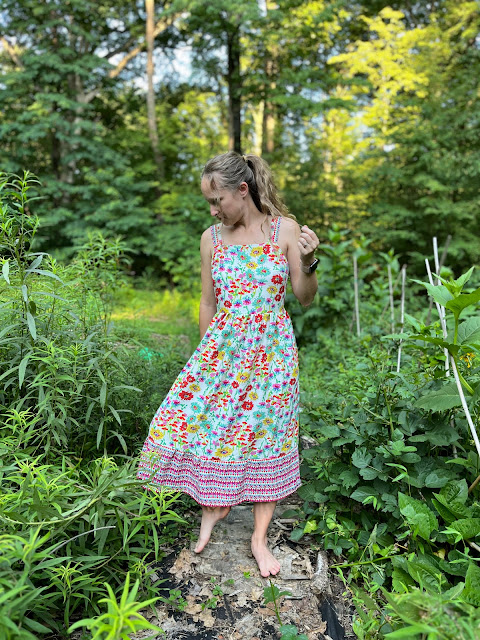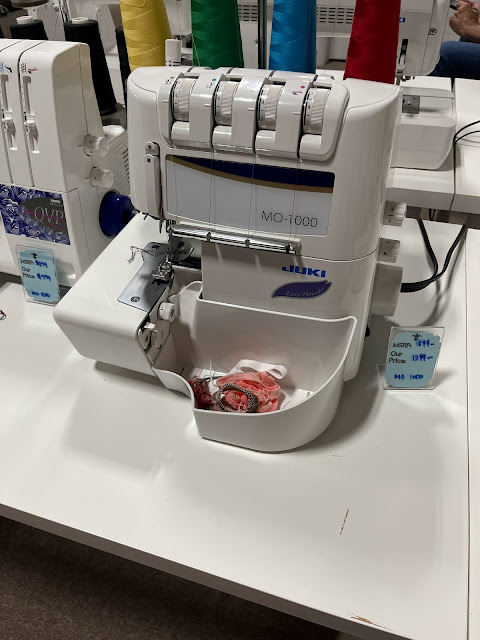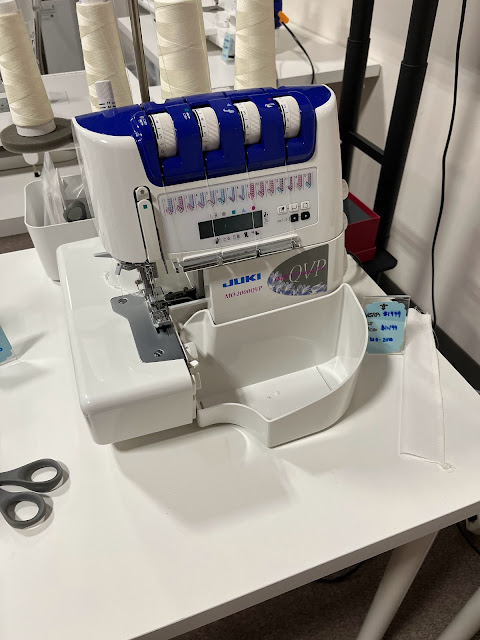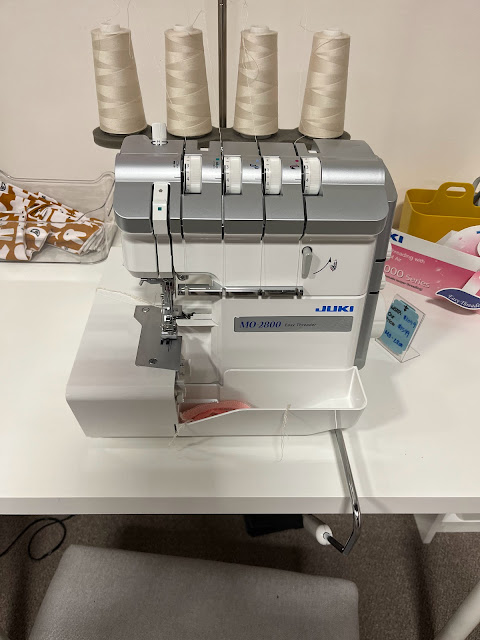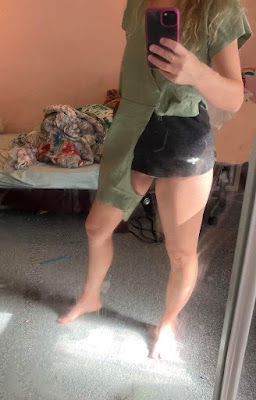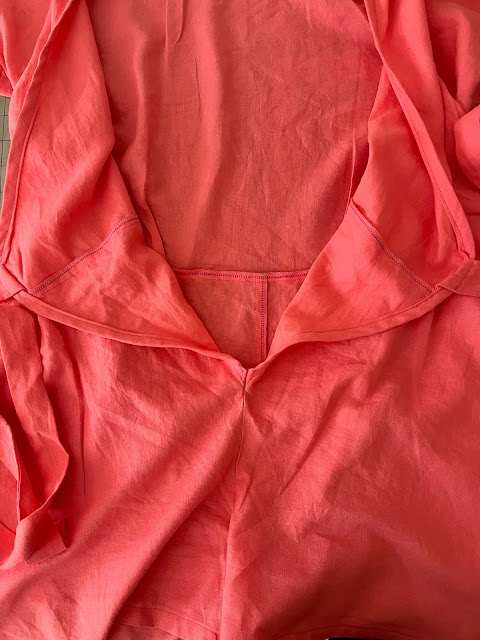Thursday, August 10, 2023
Sew DIY Eva Crop and Sundress
Tuesday, August 8, 2023
Why I Chose a Juki MO-2800
Have you ever gone to an animal shelter to adopt a kitten or a baleful-eyed dog and been like, "oh my gosh, this is such a big decision, I can't decide, and they are all so adorable!" That's basically what it's like to pick out a second tier sewing machine.
It's so easy to find a beginner machine. Just go to Amazon and type in "beginner sewing machine" and boom, there's the Brother CS-6000i. Type in "beginner serger" and boom, Brother 1034-d. A gajillion reviews and YouTube videos and all the info you could possibly need. But picking a SECOND tier machine? That's like picking a kitten.
Last year, my Brother 1034-d got a little finicky on a paid sewing job, and I had to take it in to the shop. It was the first time it had ever been serviced. It's never quite been the same after that. Last week, I once again broke the timing on it on the last six inches of another paid sewing job. It's a $300-$400 machine, and it just did not make sense to sink $100 into it for service again. I tried fixing it on my own (I've got an Instagram highlight saved if you need info on the proper way to fix the timing) but honestly, it felt like a waste of time.
After it broke the first time, I knew its days were numbered and I needed to start looking at an upgrade. But I was completely overwhelmed with options. I've always had Brother machines, but I didn't necessarily want another Brother. People love to talk about their fancy Babylock sergers, but fancy doesn't always mean best. I also did not need a combo machine because I have a dedicated coverstitch.
My first step was to search serger reviews on Pattern Review. I saw a lot of highly rated Juki machines. I went down the Juki rabbit hole and found three not-beginner sergers that were "reasonably priced" (in quotes because this is entirely subjective) between $1000-$2000 USD. Considering I made a $300 serger last 10 years, that price range seemed pretty acceptable.
I called the nearest Juki dealer, who is about an hour away. It also happens to be my favorite "local" shop, which carries high end apparel fabrics, indie patterns, sashiko supplies, all kinds of good stuff. They had the three machines I was considering available as floor models for me to try.
I went to The French Seam and spent some time with the owner reviewing these three machines:
Juki MO-1000, retail $1300
Juki MO-2000, retail $1500
Juki MO-2800, retail $1600
First impressions of all three machines: way better than my Brother. Each one had fantastic stitch quality. All three had air threading. The variety of stitch options was pretty much the same.
The 1000 and the 2000 were almost identical in function, except that the 2000 has an LCD display to give you all the stitch settings without you needing to pull out the manual.
The 2800 was the mack daddy of them all. Bigger machine. More space on the bed vertically and horizontally. Optional table add-on (didn't get it...yet). And one very, very important feature: a knee lift.
If I had never used a knee lift before, I probably would've been fine with the 1000. But I've been spoiled with the knee lift on my regular machine (Brother PC-420). I've tried to use other machines without a knee lift and I can't do it anymore. The knee lift is like a third hand when you're sewing. Would you pay an extra $300 for a third hand?
Turns out, I would. The MO-2800 should last me many years, and thinking about $300 spread out over a decade...yeah. Of course get the knee lift.
It is also quiet(er), and easy to thread, and it doesn't shake my sewing table. It's sturdy and sews beautifully. Of course, I'll update after more time, but for now I am thrilled with this machine!
Thursday, August 3, 2023
Zadie Jumpsuit by Paper Theory
There are a few sewing patterns that have achieved Platinum status. Ginger Jeans. Vogue 9253. Hinterland Dress. Ogden Cami. And the Zadie Jumpsuit!
If you haven't already made this pattern, you've got it on your list. It's one of those patterns that every time I see one, I think, that looks great on that person and I need to make one! But it wasn't until the Social Sewists at Workroom Social had a sewalong that I finally did it!
Disclaimer: I've been freelancing for Jennifer at Workroom Social for a few months. I have free access to the Social Sewists network and Jennifer purchased the Zadie pattern for me. That said, I was not asked to write or talk about the process and this is not a paid post.
During the Zadie sewalong, I attended as many of the live Zoom sessions as I could. I also appreciated that they were recorded, and I could watch them back later. Social Sewists is hosted on an app/website called Mighty Networks, which is easy and fun to use (no Facebook required). All the Zadie classes are neatly organized in one place.
The session on choosing a size for Zadie was SO SO SO helpful! Jennifer walked through different student measurements, compared them to the size chart, and discussed how the amount of ease might look depending on which size that person chose.
I'm pretty sure everyone has heard that sizing on Zadie can be hard to nail down, which is what has always intimidated me about the pattern. But after the sizing session with Jennifer, I felt totally ready to start.
My measurements are 33-28-38. According to the chart, that would put me at an 8-10/12-10/12. There is 5 1/2" of ease in the bust, 7" of ease in the waist, and 8" of ease in the hips. That's...a lot. Many people in the class expressed concern about the dreaded saggy-butt look.
I decided to muslin a size 6 (the smallest size) in the bodice and an 8 in the hips. Note that this is one full size down for each area (waist and hips I'm between 10 and 12). I have a long torso despite only being 5'4", so when I make a jumpsuit I do like to check where the waist is going to hit me. The pattern is drafted for 5'7" but spoiler alert: the bodice length was fine with no adjustments. If you have a short torso, definitely check that.
I highly recommend a muslin of the top with one pant leg. That's a weird thing to say, and mine was totally by accident (lack of fabric) but the one leg ended up being super helpful! Here's my single crappy photo that I took:
You can see here that the crotch curve is crazy deep. You do need the crotch to be low enough that you can sit down, but this looked bonkers low.
There are lengthen/shorten lines on the pattern piece right through the hip line. Typically, you see those lines across the legs, so it was kind of weird that it was in the hip. As if the designer KNOWS that the crotch is too deep.
On my muslin, I pinched out 1 1/2" across the hips/crotch and made sure I could still move and sit down. I could, so I made the change to my paper pattern and got to work on my final version.
The fabric I used is a Barbie-pink washed linen from LA Finch Fabrics. While I love the color, and the fabric is very soft, it is sort of sheer. I ended up pairing a light pink bodysuit with the jumpsuit and it eliminates any issues with the fabric being see-through.
Once the fit issues are handled, the pattern comes together crazy fast. For a jumpsuit anyway. The directions are good and I had no issues with assembly.
Last weird thing about this pattern: the cross-over in front. I never understood how it worked until I had the pattern in hand. It's hard to explain in words, so check out this Reel I made showing how it ties and unties. It weirds me out a bit to have the center front cut all the way down to the crotch, but once again, the bodysuit underneath keeps everything locked up nicely.
I only had two yards of fabric, so I couldn't make the full leg version. I would sew this again to make the long pants. Maybe in a dressy fabric for a fancy jumpsuit.
If you're interested in learning more about the Social Sewists, you can read about it here. I could not believe how much I learned from one simple video about choosing a size! This is not an affiliate link, and I do not receive anything for sending you over there.
Are you on the Zadie bandwagon, or still running to catch up? Let me know in the comments!
Newsletter sign up
You Know You Wanna
Signup for news, special offers, and bad puns!
Thank you!
You have successfully joined our subscriber list.







